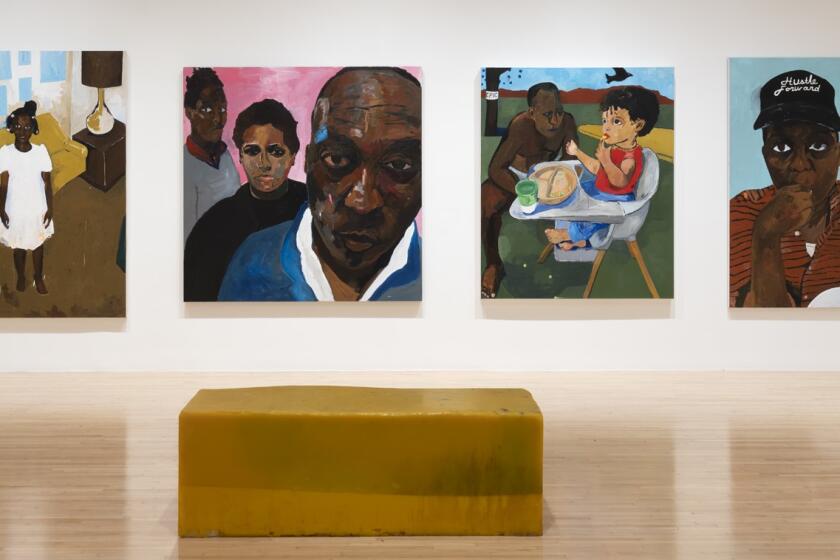Review: A new exhibit on how French decorative arts inspired Walt Disney is mostly hollow
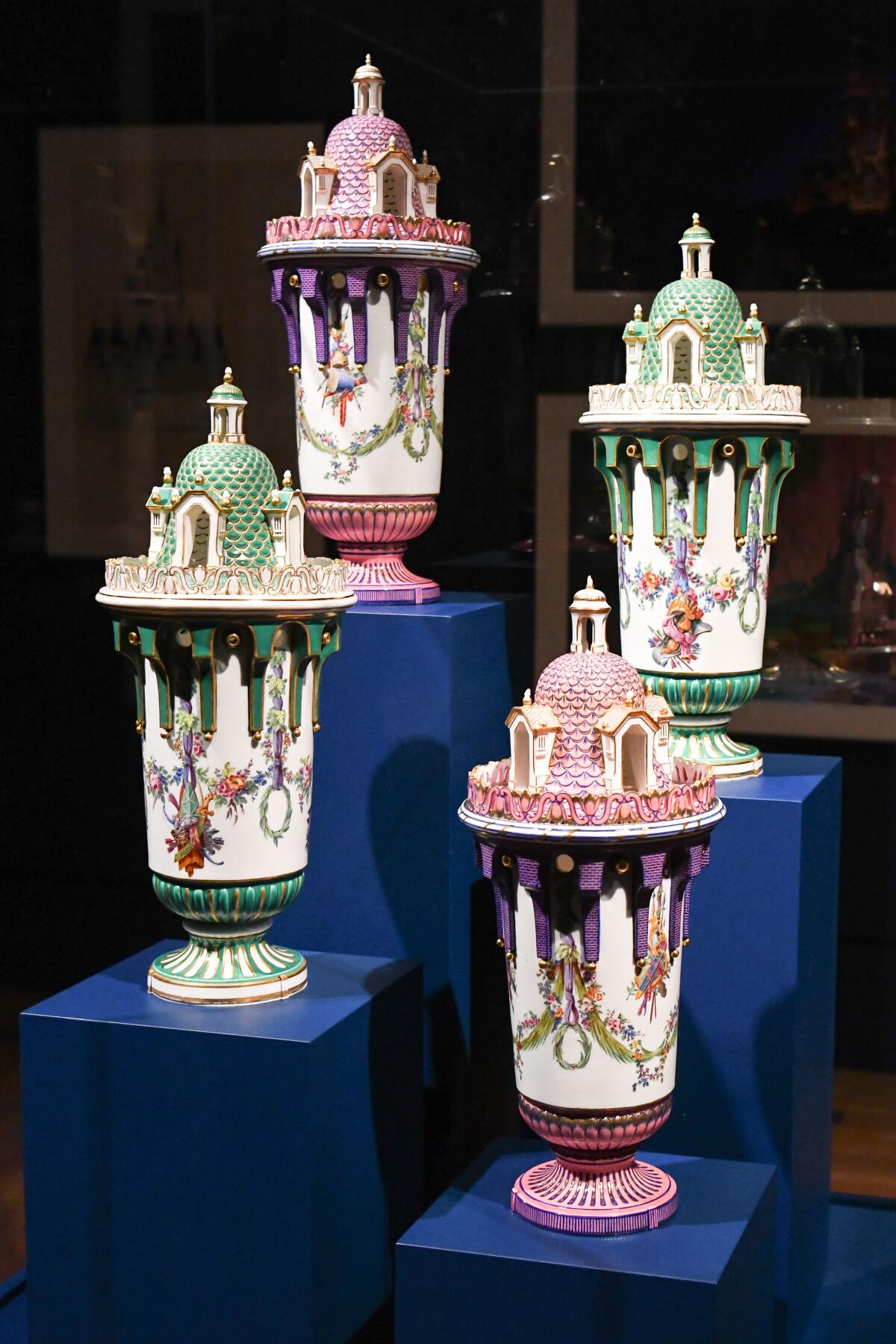
- Share via
Art museums have a really tough time dealing with Hollywood product in a coherent and illuminating way. Mass culture and art culture are not the same thing, so the usual curatorial strategies often run aground.
The latest example is “Inspiring Walt Disney: The Animation of French Decorative Arts,” newly opened at the Huntington Library, Art Museum, and Botanical Gardens in San Marino. The plan is to show how 20th century Hollywood looked at 18th century Rococo Europe in search of visual sources for everything from Sleeping Beauty’s Disneyland castle to celluloid Cinderella’s ballgown.
And especially for “Beauty and the Beast” — lo and behold, just in time for this week’s 30th anniversary TV special reviving Disney’s beloved 1991 musical animation spectacle on ABC and Disney+. (Apparently the + is for the extra year of said anniversary.) Isn’t that lucky?
Or, at the very least, tacky, sort of like the cartoon wall murals in the galleries where the show is installed. Swooping staircases and ormolu furnishings offer bland painted context for a relatively small handful of 18th century French and German decorative objects — teapots, candlesticks, dinnerware, a tall clock and such — plus engravings, book illustrations, poster graphics, some tourist souvenirs, a few film clips and concept art for assorted Disney projects, including theme parks in Paris, Hong Kong and Anaheim.
It’s mostly piffle. The single moment of delight comes at the end, when two pairs of wildly crazy “tower vases” for potpourri, each nearly 2 feet tall, show up.
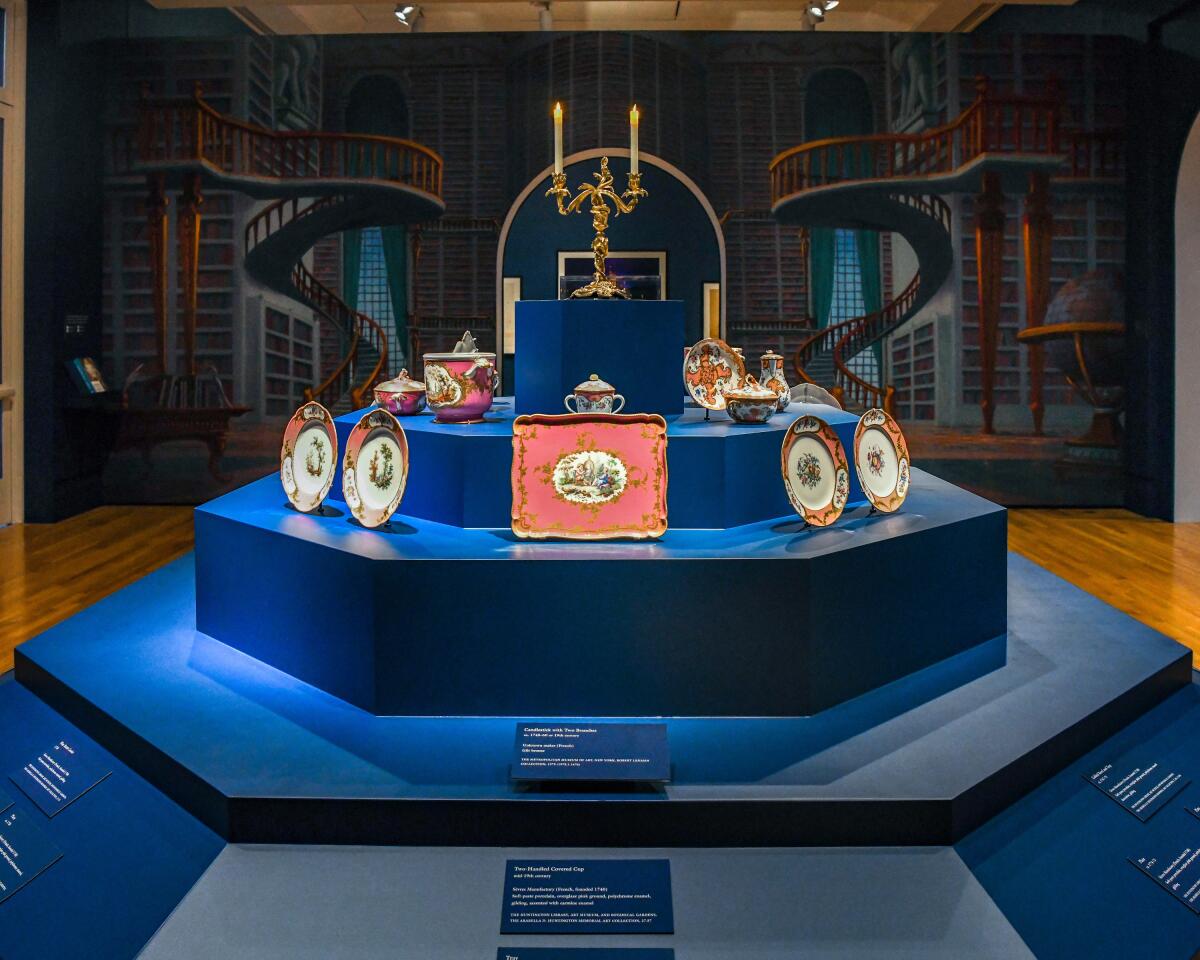
They’re attributed to sculptor and Sèvres porcelain designer Étienne-Maurice Falconet, best known for his colossal, 1782 bronze statue of Peter the Great on rearing horseback in St. Petersburg, Russia. The Huntington acquired one pair of the vases in 1927, the Metropolitan Museum of Art in New York acquired the other pair in 1956. The architectural towers sport cupolas, buttresses, dormers and booming cannons, and they’re decorated with floral garlands, war-trophy cartouches and jewel-toned colors. We’re in the visual vicinity of Sleeping Beauty’s fictive castle, which was mostly inspired by Neuschwanstein, an actual 19th century castle in the Bavarian Alps.
The show, organized by the Met and the Wallace Collection in London, where it has already been seen, has been scaled way down for presentation at the Huntington. New York’s list of 60 works of 18th century European decorative arts and design has been drastically cut to San Marino’s 19, now padded with a big display of the Huntington’s own Sèvres dinner set. The dishware pyramid is topped by a twirly candle-holder meant to put you in mind of Kevin Lima’s snappy design for Lumière, the movie’s chief of the household staff who has been transformed into a lively candelabrum by a cruel enchantress.
In some respects, this much smaller version is a benefit. We’re talking here of neither an abundance of absorbing art nor revelatory cultural rocket science. After all, if you’re going to produce an animated movie telling an 18th century European romantic fable, looking to 18th century European art for visual ideas isn’t exactly a stroke of genius. Between Charles Perrault writing moral fictions in France and the Brothers Grimm spinning parables in Germany, the era represents the zenith of the fairy tale genre. What else would you do?
When I saw the show at the Met in the spring, where its thin premise was stretched interminably in room after room, my eyes soon glazed over. Seen one gold curlicue trim from a candelabrum transferred to the interior design of the cinematic Beast’s Castle, seen ’em all. At the Huntington, smaller is definitely better.
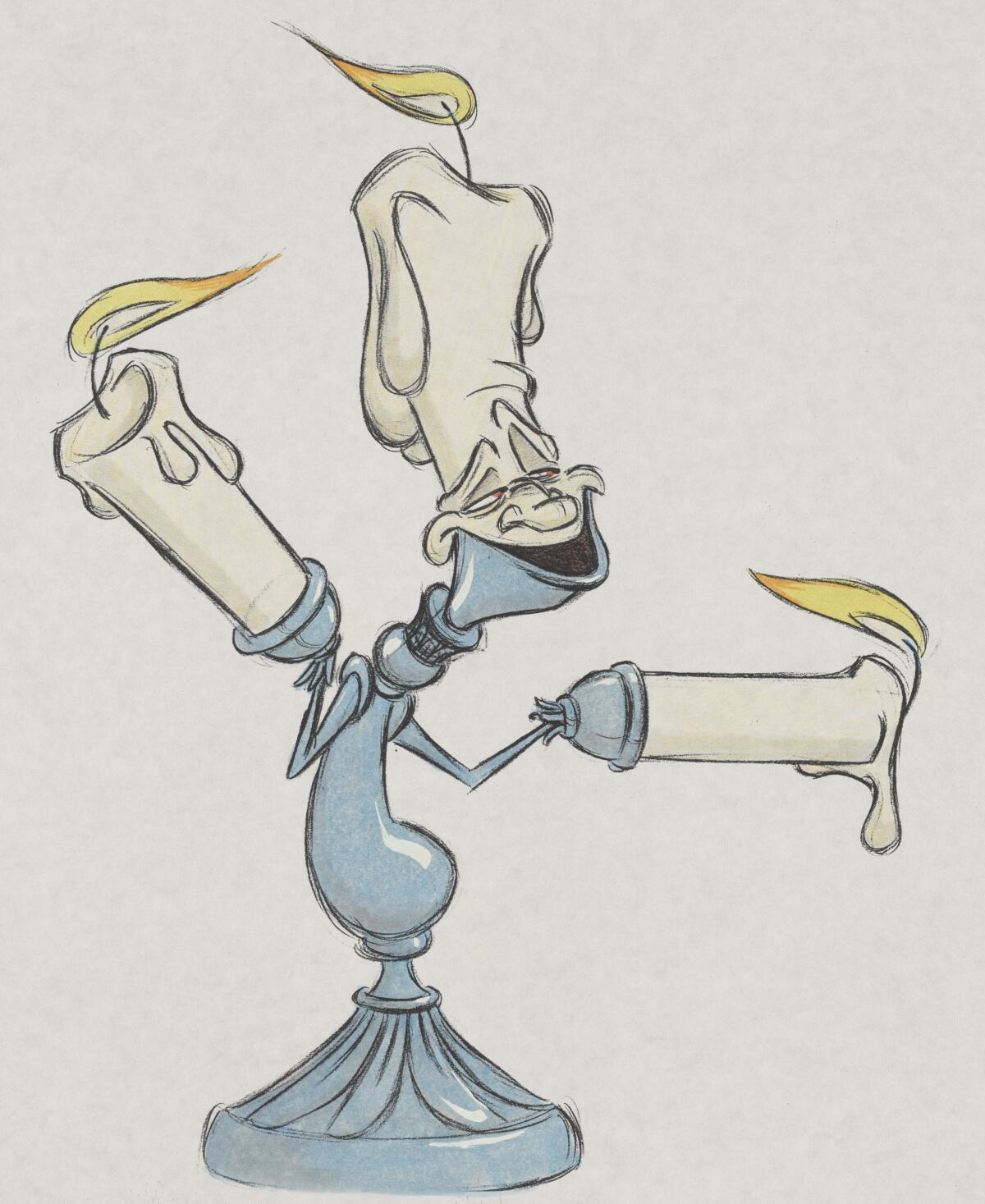
One problem with the show is that none of the objects in it was a specific inspiration for the animator’s caricatures. Everything is generic, imprecise and loosey-goosey. Mrs. Potts, motherly head of the Beast’s kitchen and cheerfully drawn in pastel by Chris Sanders, is just vaguely like that fat German faience example of a teapot on view in a nearby vitrine. Lumière is nowhere near as ornate as the florid Huntington candelabrum.
Close enough? Not really, except superficially — but you get the idea.
The difference between generic and specific is fundamental to the difference between mass culture and art culture, but the show doesn’t address the critical distinction. Instead, you’re left thinking that the museum is perhaps unintentionally fluffing up legitimacy for Hollywood cartoons with an artistic pedigree — which Disney doesn’t even need. The animated rags-to-riches fantasy of something like “Beauty and the Beast” is pretty remarkable in its own right.
This was Walt Disney’s idea of bringing European high culture to the American masses. Having failed at that — see the tumultuous saga of “Fantasia,” which the movie critics mostly loved and the classical music critics mostly hated (“execrable,” said Igor Stravinsky, whose music was featured in the film) — he invented something distinctive in the process.
It’s probably instructive that on his European travels, Disney collected knickknacks, not art, to bring back to Burbank. The show has displays of miniature furniture, tiny tools and souvenir dishes that he bought. Gewgaws were as much an inspiration to him as the superlative workshops of Sèvres or Fragonard’s studio.
One surprising omission: No lavishly decorated snuff boxes are in the show, even though fermented, pulverized tobacco from Europe’s plundered colonies was the addictive drug of choice for idle aristocrats. It seems a missed opportunity, given the generations of American consumers getting high to indulge the modern ritual of watching the dancing hippos and twirling mushrooms of “Fantasia.”
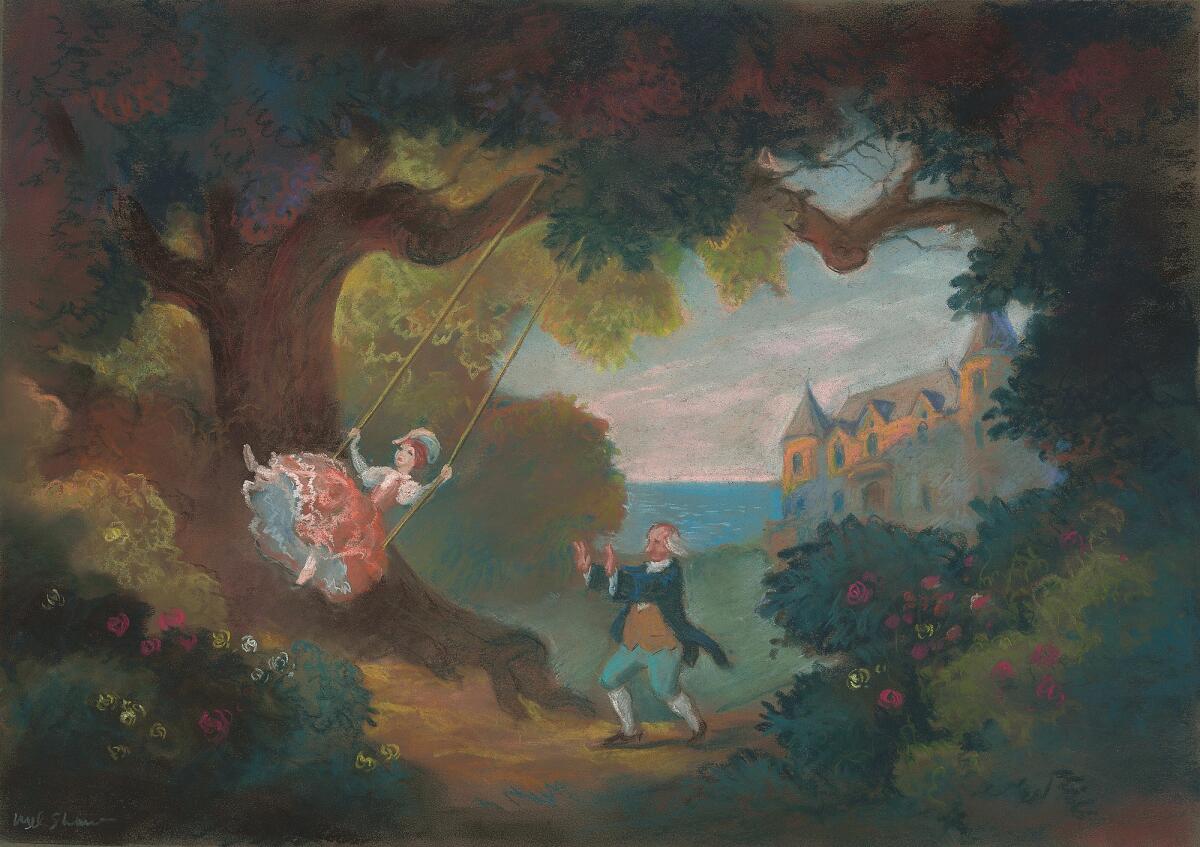
Also missing: the original show’s single greatest object.
Jean-Honoré Fragonard’s famous frothy painting of a woodland dalliance, “The Swing” (circa 1767), the Wallace Collection’s signature canvas, was originally featured as a model for an opening sequence in “Beauty and the Beast” but later cut from the film. It also got cut from the shrunken exhibition, where it might have added some clarity.
How? The luminous painting’s full if rarely used title is “The Happy Chances of the Swing,” because the extraordinary picture shows a young lady’s suggestively pink dress blowing up in the breeze as she rides a velvet swing in a sumptuously enclosed garden. The “happy chance” is an unexpected opportunity for her lover, who kicks back lying prone in the bushes beneath her, to get a gander of the target of his ardor hidden within all those billowing petticoats.
Forget Disney. The true Hollywood parallel is Billy Wilder offering the tease of Marilyn Monroe cooling her privates on the breezy subway grating in “The Seven Year Itch.” Happy chances of the Uptown MTA.
Paintings, drawings, sculptures and installations that artist Henry Taylor created over the last 30 years are on view at a major MOCA show.
Eighteenth century French decorative art is nothing if not dissolutely bawdy — words not often appended to Disney’s art, which neutered French decorative arts as much as it animated them. The sensually, sexually stimulating indulgences of one are about 180 degrees from the chaste, G-rated commitments of the other. The differences between the two are what counts, but this show goes for the surface similarities between art culture and mass culture. The forthright intentions of each are left out.
No sex, no drugs — the inspiration is real but shallow, not deep. While occasionally amusing, so is this exhibition.
‘Inspiring Walt Disney: The Animation of French Decorative Arts’
Where: Boone Gallery, Huntington Library, Art Museum, and Botanical Gardens, 1151 Oxford Road, San Marino
When: 10 a.m. to 5 p.m. Wednesdays through Mondays. Closed Tuesdays. Through March 27.
Cost: $13 to $29
Info: (626) 405-2100, huntington.org
More to Read
The biggest entertainment stories
Get our big stories about Hollywood, film, television, music, arts, culture and more right in your inbox as soon as they publish.
You may occasionally receive promotional content from the Los Angeles Times.
